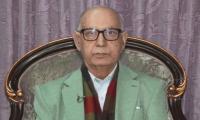The development of the first vaccine in the 1790s drastically changed preventive health. Achieving wide immunity (herd immunity) could potentially mean complete eradication of a communicable disease.
Smallpox became the first such disease; the last smallpox patient was seen in 1980. This phenomenal success raised hopes and in 1988 the World Health Assembly resolved to eradicate polio from the world. However, contrary to smallpox, polio eradication faced complex challenges. In a way, smallpox eradication was relatively simple as it only required two basic strategies: search and contain. The search component was easy because of apparent signs of infection and containment was possible by building an immunity wall through ring immunization using a vaccine that was heat stable. In comparison, only one out of approximately 200 infected with polio is symptomatic. Moreover, logistically huge quantities of temperature sensitive vaccine need to be carried to every child to build the required immunity.
Nevertheless, the global investments in terms of resources and efforts have resulted in over 99 percent case decline and the number of endemic countries stands reduced from 125 in 1988 to only two today: Pakistan and Afghanistan. In 1988 more than 1000 children were being crippled everyday in the world. In 2019, this number was less than one (0.45) child per day.
Pakistan started organized efforts for polio eradication in 1994 and our valiant frontline workers have successfully averted over 875,000 cases of polio-related paralysis and deaths. In the meanwhile, types 2 and 3 of the polio viruses have been eradicated in 1997 and 2012 respectively, leaving type-1 (WPV1) as the only wild virus still circulating.
Our journey towards attaining a polio free status so far has been marked with many ups and downs. The annual cases were brought down to double digits around 2005, but started rising again which prompted the country to declare polio a national public health emergency in 2011. The renewed focus had some impact but the simultaneously emerging security challenges led to the programme’s inaccessibility to over 600,000 vulnerable children resulting in huge outbreaks in 2014.
Operation Zarb-e-Azb followed by the active support of security forces facilitated polio workers in reaching all children. The scientific management, effective coordination and one-team approach practised by all government stakeholders as well as the international partners under the network of the Emergency Operations Centres worked and brought polio cases down to only eight in 2017 and 12 in 2018.
Sadly, 2019 again saw an upsurge and 136 children have been paralyzed by the wild polio virus (WPV1). The emergence of Vaccine Derived Virus strain (VDPV2) in the second half of 2019 has further compounded our challenges and quite understandably has given rise to serious concerns – although VDPV2 is not limited to Pakistan.
The virus has to be wiped off from remaining zones of existence within Pakistan and Afghanistan as soon as possible. It is therefore, the time to step back, look at the experiences and strategize afresh.
Our efforts so far have been continuously challenged by weak routine immunization, and poor water and sanitation that provide a conducive environment for the virus to survive and thrive, as well as the high prevalence of malnutrition among children. The enormous population mobility within Pakistan and Afghanistan as well as across borders further makes it hard.
In 2019, there indeed has been a loosening of focus affecting the quality of programme operations on ground. However, at the heart of it have been longstanding community deprivations in terms of unmet health and other needs. In the backdrop of this, frequent knocks by teams for polio vaccination generated reactions and also caused front-line workers’ fatigue. Propaganda incorrectly relating incidents to vaccine safety, such as the one in Peshawar in April 2019, hugely exacerbated the pre-existing resistance.
Resultantly, at the advent of 2020, we are challenged by the high number of polio cases and persistent presence of the virus in the environment. Our goal is very clear: we have to collectively ensure a paralysis-free future for our children. The government, with support from global partners, has accordingly set out a clear roadmap for 2020.
The programme has taken on board the critical feedback from the global Technical Advisory Group and International Monitoring Board to transform the programme to make it fit for the purpose. The intended transformation is not only in terms of structures and functions but more importantly in terms of the mindset.
With hope, courage, confidence, determination, discipline and the unwavering commitment of frontline workers, polio eradication efforts are being brought on track. The political commitment and strong support by the Pakistan Army and the civil society was evident in a successful nationwide door-to-door polio vaccination campaign in December 2019 – the first conducted after a seven-month lag.
Around 265,000 workers were able to reach every house across the country, vaccinating almost all our children up to five years of age – almost 40 million, in three to five days. The community was quite receptive this time and a massive reduction of missed children was witnessed at the end of the campaign – going down from 1.8 million (4.5 percent of the total target) in the April 2019 national campaign to 0.5 million.
Data further shows a significant reduction in community resistance as the number of children missed due to refusal declined nationally from 999,415 million (2.54 percent) in April 2019 to 228,179 (0.6 percent) in December. During the campaign, our workers identified over 363,000 children who had not received any dose in routine schedule. Union council details of such clusters were handed over to the EPI for targeted outreach activities that are currently underway. These integrated efforts will certainly have a huge impact on plugging the current immunity gaps.
While the overall progress is encouraging, we have observed that many of the resistant families live in proximity with each other and largely in core reservoir areas – Karachi, Peshawar, and the Quetta block (Quetta, Pishin and Killah Abdullah) as well as the pockets within districts in southern Khyber Pakhtunkhwa. These clusters of unprotected children still run the risk of getting paralyzed and cause continued circulation of the virus. An important part of our effort has been to segregate them by reason and identification of appropriate influencers to address their misconceptions well before the next campaign scheduled in February.
Besides promoting polio eradication as a shared priority and the critical EPI-PEI integration, the National Emergency Action Plan for 2020 also outlines a few bold strategies. We have identified 40 super-high risk union councils in core reservoir regions. Here, we are strengthening infrastructure, human resources, oversight and accountability to improve the quality of polio campaigns as well as the essential immunization coverage. Broader partnership with the Ehsaas programme and other relevant stakeholders is accordingly being established.
The polio immunization campaign modality has been revised with a view to vaccinate all children within dedicated campaign days and with adequate interval between campaigns to ensure enough time for campaign preparation and implementation of community engagement activities.
The formula for success is very clear: a constant and vigilant look at the remaining gaps and challenges, and a collective approach to strategically overcome them. The programme has a busy time ahead and the success of two nationwide campaigns in February and April coupled with strategic response rounds in January and March shall significantly reduce the transmission intensity to the 2017-18 level, setting the stage for our final push towards Zero.
Federal and provincial governments have jointly outlined a strategic path to our national success and are fully committed to improve the efficiency and effectiveness of polio eradication efforts as well as enhanced demand for vaccination against all preventable diseases. Our frontline polio workers are the lynchpin in our polio eradication effort and I salute them for their commitment, hard-work and bravery. Forty-five of our colleagues have lost their lives while delivering polio drops to children in their homes (34 died in other incidents) and many more got injured. We will never forget these martyrs.
Let us come together as a nation to achieve a polio-free Pakistan to protect our future generations.
The writer is the state minister for health.
Survey conducted in prisons highlights distinct patterns of crime shaped by socio-economic and demographic factors
Pakistan’s urban planning remains fixated on vanity projects, flyovers, underpasses, and highways
Most recently, US presidential elections demonstrated how AI has amplified partisan split
Few years ago, Pakistan ranked as fourth-largest freelancer market globally, with potential to become number one
Arts Council Karachi celebrated its 70th birth anniversary at inaugural session with big cake
There are over 11 million Pakistanis settled abroad, out of which around six million work in Gulf and Middle East







